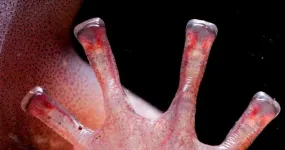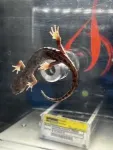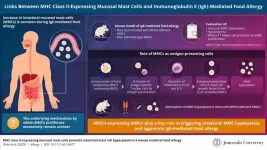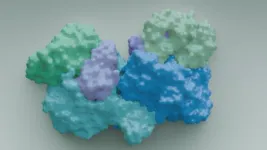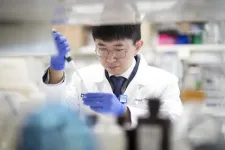(Press-News.org) PULLMAN, Wash. — Wandering salamanders are known for gliding high through the canopies of coastal redwood forests, but how the small amphibians stick their landing and take-off with ease remains something of a mystery.
A new study in the Journal of Morphology reveals the answer may have a lot to do with a surprising mechanism: blood-powered toes. The Washington State University-led research team discovered that wandering salamanders (Aneides vagrans) can rapidly fill, trap, and drain the blood in their toe tips to optimize attachment, detachment and general locomotion through their arboreal environment.
The research not only uncovers a previously unknown physiological mechanism in salamanders but also has implications for bioinspired designed. Insights into salamander toe mechanics could ultimately inform the development of adhesives, prosthetics, and even robotic appendages.
“Gecko-inspired adhesives already allow surfaces to be reused without losing stickiness,” said Christian Brown, lead author of the study and an integrative physiology and neuroscience postdoctoral researcher at WSU. “Understanding salamander toes could lead to similar breakthroughs in attachment technologies.”
Discovery sparked by a documentary shoot
Salamanders of the Aneides genus have long puzzled scientists with their square-shaped toe tips and bright red blood “lakes” that can be seen just beneath their translucent skin. Historically, these features were thought to aid oxygenation, but no evidence supported that claim.
Brown’s interest in the topic traces back to an unexpected observation during the filming of the documentary, “The Americas,” which airs on Feb. 23 on NBC and Peacock. While assisting on set as the resident salamander expert, Brown had the opportunity to observe through the production team’s high-powered camera lenses how the amphibians move around.
He noticed something strange. Blood was rushing into the small creatures’ translucent toe tips moments before they took a step. Brown and camera assistant William Goldenberg repeatedly observed the phenomenon. “We looked at each other like, ‘Did you see that?’” Brown said.
Though the producers moved on, Brown’s curiosity didn’t. After the shoot, he reached out to Goldenberg and asked if he was interested in using his film equipment to investigate what they had observed in a scientific and repeatable way.
Through high-resolution video trials and corroborating analysis in WSU’s Franceschi Microscopy & Imaging Center, Brown, Goldenberg and colleagues at WSU and Gonzaga University uncovered that wandering salamanders can finely control and regulate blood flow to each side of their toe tips.
This allows them to adjust pressure asymmetrically, improving grip on irregular surfaces like tree bark. Surprisingly, the blood rushing in before “toe off” appears to help salamanders detach rather than attach. By slightly inflating the toe tip, the salamanders reduce the surface area in contact with the surface they are on, minimizing the energy required to let go. This dexterity is crucial for navigating the uneven and slippery surfaces of the redwood canopy—and for sticking safe landings when parachuting between branches.
“If you’re climbing a redwood and have 18 toes gripping bark, being able to detach efficiently without damaging your toe tips makes a huge difference,” Brown said.
The implications of the research could extend beyond Aneides vagrans. Similar vascularized structures are found in other salamander species, including aquatic ones, suggesting a universal mechanism for toe stiffness regulation that may serve different purposes depending on the salamander’s environment. Moving forward, Brown and colleagues plan to expand the research to look at how the mechanism works in other salamander species and habitats.
“This could redefine our understanding of how salamanders move across diverse habitats,” Brown said.
END
Blood-powered toes give salamanders an arboreal edge
2025-01-29
ELSE PRESS RELEASES FROM THIS DATE:
Better nurse staffing linked to fewer C-sections
2025-01-29
Labor and delivery units that are adequately staffed by nurses have lower cesarean birth rates, according to new research published in the journal Nursing Outlook.
“Our findings highlight how crucial nurse staffing is for optimal maternal outcomes,” said Audrey Lyndon, the Vernice D. Ferguson Professor in Health Equity and executive vice dean at NYU Rory Meyers College of Nursing.
C-sections account for nearly a third of births in the US and are the most common surgery performed in hospitals. While C-sections can be lifesaving and some are necessary for the health of the mother and child, the surgery carries more risks and a longer recovery ...
Role of specialized mucosal mast cells in IgE-mediated food allergy
2025-01-29
Food allergy, or the aggressive immune system reaction following the consumption of a certain food or food ingredient, typically involves immunoglobulin E (IgE) antibodies and can be potentially life-threatening. Often, the immune response to a food protein can be rapid and severe, requiring emergency care. In recent years, scientific studies have revealed that mucosal mast cells (MMCs), which are immune cells that arise from bone marrow, are excessively produced and play a key role in the severity and sudden onset ...
Study reveals how microbes help detoxify our atmosphere
2025-01-29
Melbourne researchers have discovered crucial new information about how microbes consume huge amounts of carbon monoxide (CO) and help reduce levels of this deadly gas.
Over two billion tonnes of carbon monoxide are released into the atmosphere globally each year. Microbes consume about 250 million tonnes of this, reducing CO to safer levels.
The Monash University-led Study, published in Nature Chemical Biology, reveals at an atomic level how microbes consume CO present in the atmosphere. They use a special enzyme, called the CO dehydrogenase, ...
White blood cell count could predict severity of COVID-19 symptoms
2025-01-29
CLEVELAND, Ohio (Jan 29, 2025)—Thanks to advances in treatment options, a COVID-19 diagnosis is no longer as scary as it once was, at least for most people. A new study, however, suggests that it may now be easier to predict who is most likely to suffer with more serious disease symptoms based on leukocyte (white blood cell) count. Results of the study are published online today in Menopause, the journal of The Menopause Society.
Millions of people worldwide suffer from the ongoing effects of COVID-19—which is caused by the SARs-CoV-2 ...
Moderate exercise keeps appetite at bay
2025-01-29
A recent study involving researchers at Murdoch University’s Health Futures Institute has revealed that moderate-intensity exercise can significantly influence appetite-related hormones and perceptions in males with obesity.
The study, titled “Acute effect of exercise on appetite-related factors in males with obesity,” provides new insights into how exercise can aid appetite control and weight management.
One of the study authors, Associate Professor Timothy Fairchild from Murdoch’s School ...
Cancer drugs linked to severe chronic peripheral nerve pain for 4 in every 10 patients
2025-01-29
Worldwide, cancer chemotherapy is linked to persistent severe peripheral nerve pain (neuropathy) for around 4 in every 10 patients treated with these drugs, suggests a pooled data analysis of the available evidence, published in the open access journal Regional Anesthesia & Pain Medicine.
Notwithstanding wide regional variations, platinum based drugs, taxanes, and lung cancer seem to be associated with the highest rates of persistent painful neuropathy, lasting at least 3 months, the findings suggest, prompting the researchers to call for tailored approaches to pain ...
Lack of essential vitamins and minerals common in people with type 2 diabetes
2025-01-29
Micronutrient deficiency, whereby levels of vitamins and minerals essential for healthy bodily function are far too low, is common in people with type 2 diabetes, finds a pooled data analysis of the available evidence, published in the open access journal BMJ Nutrition Prevention & Health.
A lack of vitamin D is the most common ‘missing’ micronutrient, overall, the findings indicate, with women at greater risk than men of these deficiencies, dubbed 'hidden hunger.'
Genetic predisposition, various environmental factors, sedentary ...
Calorie labels on menus could make eating disorders worse
2025-01-29
Calorie labels on restaurant menus are negatively impacting people with eating disorders, according to a new study published today in the BMJ Public Health.
The review, which is the first of its kind, is led by researchers at King’s College London. It found that individuals who have been diagnosed with an eating disorder changed their behaviours if presented with a menu featuring calorie labels.
This included avoiding restaurants, triggering eating disorder thoughts and paying more attention to calorie labels as identified by eye tracking research.
The research found that some people with eating disorders reported that seeing menu labels reinforced ...
Artificial intelligence model identifies potential risk genes for Parkinson’s disease
2025-01-28
Researchers from the Cleveland Clinic Genome Center have successfully applied advanced artificial intelligence (AI) genetics models to Parkinson’s disease. Researchers identified genetic factors in progression and FDA-approved drugs that can potentially be repurposed for PD treatment.
The npj Parkinson’s Disease report uses an approach called “systems biology,” which uses AI to integrate and analyze multiple different forms of information from genetic, proteomic, pharmaceutical and patient datasets to identify patterns that may not be obvious from analyzing ...
A new register with thousands of entangled nuclei to scale quantum networks
2025-01-28
In a groundbreaking achievement for quantum technologies, researchers at the Cavendish Laboratory, University of Cambridge, have created a functional quantum register using the atoms inside a semiconductor quantum dot.
Published in Nature Physics, the work demonstrates the introduction of a new type of optically connected qubits—a critical advance in the development of quantum networks, where stable, scalable, and versatile quantum nodes are essential.
Quantum dots are nanoscale objects with unique optical and electronic properties that come from quantum mechanical effects. These systems are already used in technologies ...
